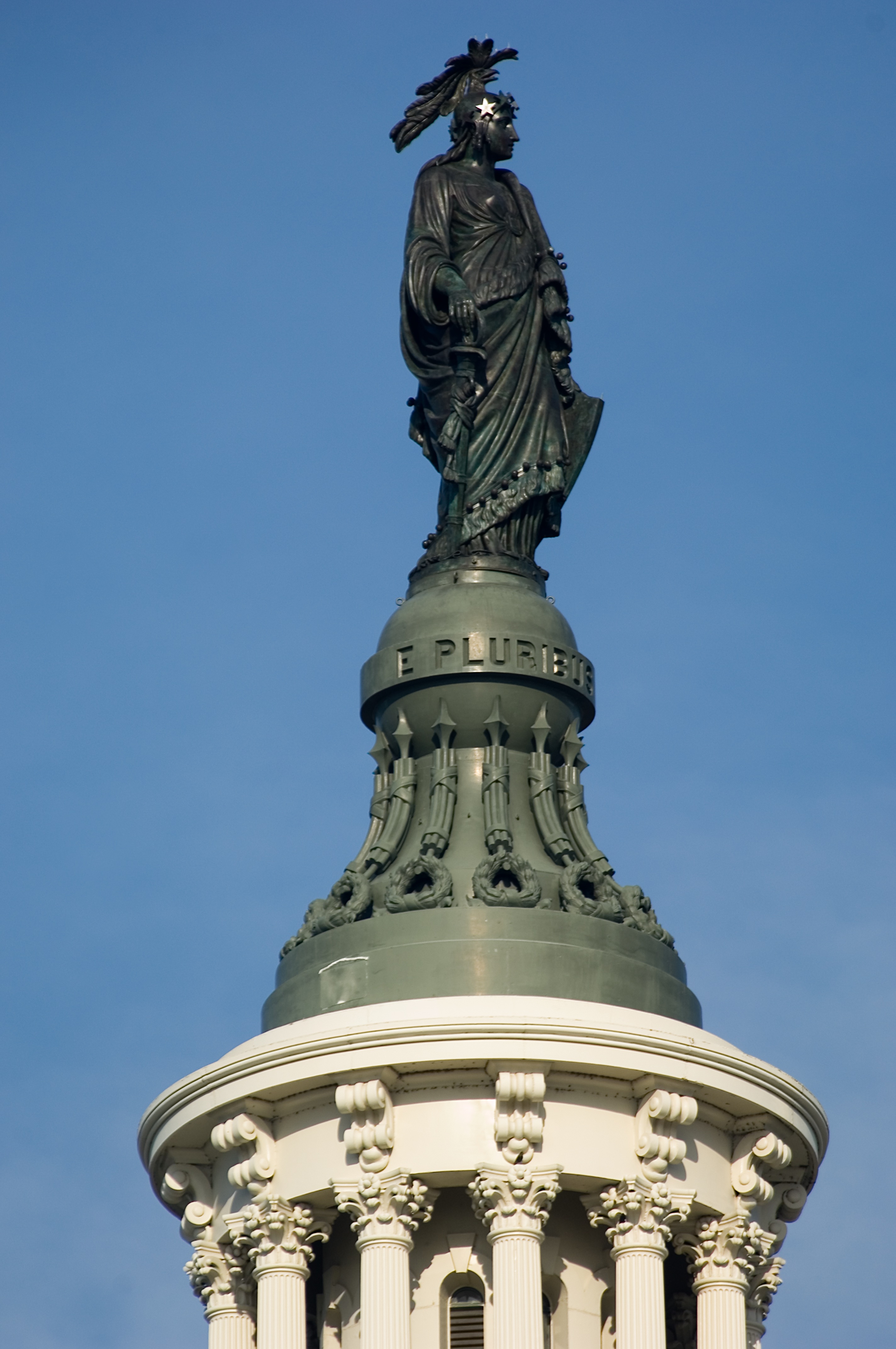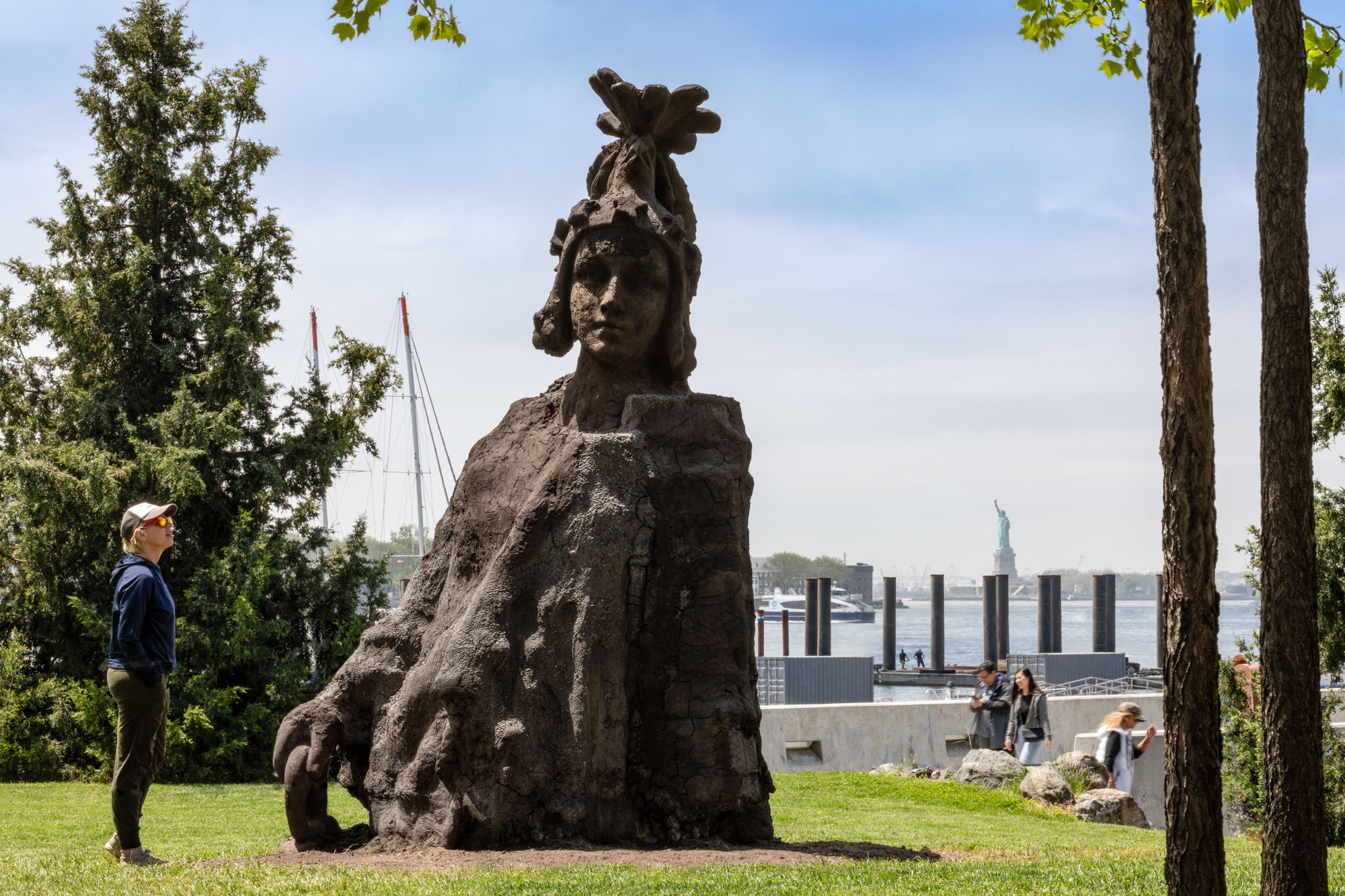Installed in a grassy enclave near Pier 3 of the Brooklyn Bridge Waterfront Park (New York), Ruins of Empire by Kiyan Williams presents viewers with an oversized female figure constructed out of bits of hardened earth. The sculpture was created for Black Atlantic, an exhibition organized by the Public Art Fund (open May 17- November 27, 2022). With its title the show looks to the work of Paul Gilroy, who developed the transnational notion of the Black Atlantic in 1993 in order to theorize cultural identities whose history has been profoundly marked by the transatlantic slave trade.1 While the exhibition as a whole comprises various site-responsive works that address aspects of Black experience in the United States, Williams’ piece offers a complex meditation on the history of monuments and public sculpture from a Black diasporic perspective.

Williams’ figure, who seems to have grown out of the park’s own soil, nonetheless has a historic lineage. Her appearance is drawn from that of the so-called Statue of Freedom, the 19th century neoclassical bronze statue created by Thomas Crawford that sits atop the dome of the U.S. Capitol in Washington D.C. Though the statue’s high placement prevents a detailed viewing, it is equipped with several patriotic additions like a laurel victory wreath, a shield featuring 13 stripes, and an inscribed pedestal that reads E pluribus unum (“Out of many, one”). In Ruins of Empire the figure is displaced from her aloof architectural perch and is brought quite literally down to earth to reckon with the nation’s complex historical record.
Both the U.S. Capitol and its crowning statue, two symbols of American democracy, were built with enslaved labor. Furthermore, Crawford’s original design, created in the 1850s, featured the female figure wearing a liberty cap. This head covering, given to formerly enslaved persons in ancient Rome, became a symbol of liberty during the American and French Revolutions and remained popular throughout the nineteenth century. Yet this symbolic language was rejected by the project’s supervisor, Secretary of War Jefferson Davis who would soon go on to become the president of the Confederacy. Declining the liberty cap, Davis proposed a helmet, which Crawford integrated into his final design.2 In so doing, the monument’s allusions to slavery—a divisive issue that would soon plunge the nation into a bitter war—were muted in favor of less overtly inflammatory symbols. However, the foundational contradiction at the root of American democracy, namely the gap between the nation’s professed ideals of equality and liberty and the reality of an enslaved population that sustained its rapid economic growth and imperial expansion, remained. The statue’s construction itself further enacted this contradictory entanglement, as the bronze casting made after Crawford’s original plaster was executed in part by Philip Reid, an enslaved laborer at the foundry tasked with producing the statue.3

It is this fundamental paradox of American history that Williams’ processes bring to the fore in Ruins of Empire. Reimagined and repositioned on ground level, the work courts viewer engagement and dialogues with its own local context in contrast to conventional monuments that maintain a distance from audiences. Beyond the shores of the Brooklyn Bridge Park, one sees the Statue of Liberty, another monument dedicated to democratic ideals. By creating visual conversations through sightlines, Williams’ work encourages viewers to reassess the claims made by this famous statue. At the same time, the work sparks reflection on the park itself, once a busy commercial port active until the 1970s. During the nineteenth century, the area was an important site of exchange and storage of sugar, tobacco, and coffee—goods whose own connections to enslaved labor and other exploitative practices are known. Beholding Ruins of Empire reactivates this salient yet overlooked historical legacy.
Williams’ choice of material furthers and nuances this historical reflection. In the shift from bronze to hardened earth, the statue’s appeal to freedom is reconfigured with respect to its nineteenth-century source. Cast bronze, a solid and enduring material, has been used for monumental sculpture since antiquity. Across various epochs, bronze has served to commemorate and sustain power, naturalize violent conquests, and promote particular ideological frameworks. As an intrinsically durable material, it functions as an efficient vehicle not only to convey political and historical narratives, but also to sediment them into a collective unconscious over time. By means of its own material manipulation by sculptors, bronze molds the minds of its public audience through particular visual configurations. Soil, on the other hand, is much less stable. Though it can be fixed into certain arrangements, it remains highly susceptible to external forces that can erode it. One sees this in Ruins of Empire, which manifests traces of material degradation. Cracks appear on its surface while detached fragments rest on its surrounding grass. Over time, Williams’ figure of freedom breaks down unlike her Capitol predecessor who remains largely impervious to the elements and other destabilizing forces. In so doing, the materiality of the work mirrors the unstable and fraught histories underpinning notions of American freedom itself that surface when the historical record is interrogated. In other words, the work materially enacts the consequences of a rigorous critique of some of America’s most naturalized ideals. Freedom is recast as tenuous and subject to external threats and decay —a timely insight for today’s politically turbulent times.

The conventional forms and materials of monumentality are fundamentally questioned in Ruins of Empire. Traditional appeals to solidity and longevity are denied in favor of an unstable and temporary configuration that subverts standard understandings of freedom. With Ruins of Empire, Williams turns a historic monument against itself to expose the erasures, fictions, and volatilities underpinning its ideological claims. As a result, rather than proclaim an empire’s glories as monuments so often do, Williams highlights the fragility and inconsistency of one of its core principles. More broadly, the artist sheds light on the ways in which public art might signify differently in order to more accurately reflect society and the experiences of its historically marginalized populations. Viewing the work, one is reminded of an observation made by Walter Benjamin in 1940, when the German thinker asserted that history is written by its victors and famously added that “there is no document of culture which is not at the same time a document of barbarism.”4 Ruins of Empire manifests the uncomfortable duality Benjamin observes, but it also reveals that history need not always been written by its victors. Indeed, when it is not, it speaks even more forcefully.
